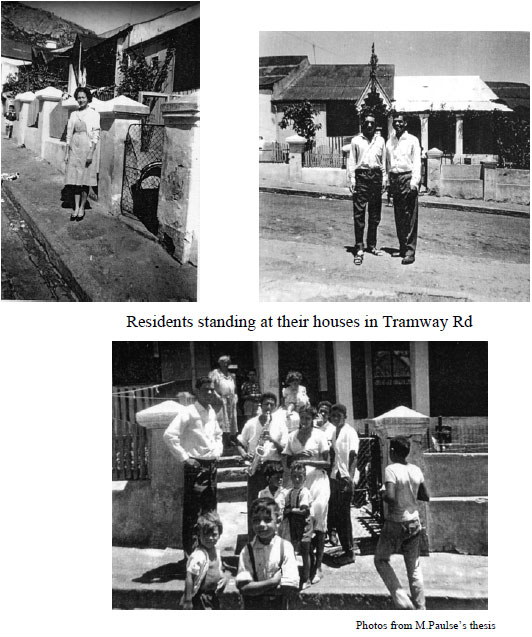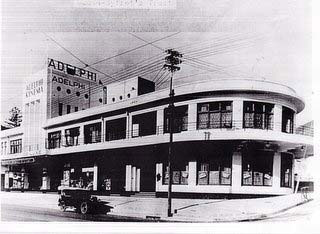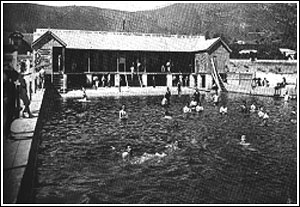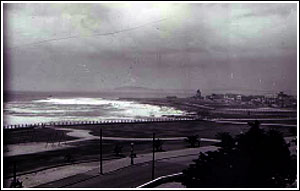data to follow
Utopia
A historical investigation into the Sea Point beachfront as a public open space throughout the 20th century with special reference to memories of growing up along the Sea Point Promenade by Leila Emdon.
Chapter Two continued – The growth of a suburb: the Development of Sea Point in the late 19th century to the 1950s
<< previous World War Two and Sea Point
The Exclusive Utopia of Sea Point- Sea Point and Apartheid
The Sea Point promenade was a safe and clean environment where the community made use of all the public facilities. After 1948, this was to become exclusively reserved for whites only.
Sea Point was always a largely white suburb, an upper class suburb as well. However, living in Tramway Road and Ilford Street was a small coloured community. “In the late 19th century, British ideas on housing workers to promote economic production influenced on the elite of Cape Town, the capital of the British Colony. In the interest of the economic production of the Green and Sea Point Tramway Company, employers who began their work day at the Sea Point terminus were to live in cottages at the Sea Point station.”42 Coloured women became domestic servants and washerwomen in the area, and the men served at the Tramway company or held working class positions in the area. Their houses were small and overcrowded, as well as dilapidated. The children could not attend the schools nearby and their houses were separated from the rest of Sea Point, so as “not to disturb the belief that the municipality belonged to a wealthy class.”43
During the earliest years of Apartheid, 1949-1953, the National Party passed racebased laws that intensified restrictions to social and political life. “Apartheid legislation intensified the radicalisation of space in the country and bestowed upon white people greater privileges then before.”44 “Demarcated space informed race identity, stimulated feelings of marginalisation, provoked agency and encouraged compliance.”45 The Sea Shore Act of 1935 obliged residents of the city to bathe in racially separate bathing areas. During the 1940s whites and blacks swam in different municipal swimming baths and the main beaches were segregated. Segregated bathing, however, had long been practised in Sea Point. By 1913, whites patronised the Sea Point Pavilion and around 1917 the city constructed a bathing pool, the ‘Non- European Pavilion’, for coloureds near Queens beach near the Sea Point railway station. While the naming of the Pavilion for whites both identified whites with the suburb and reinforced the notion of the suburb as a space for white people, the naming of the recreational site for coloureds emphasised the marginalisation of coloureds in Sea Point.46 The coloured residents of the area could only enter the Pavilion if they were a servant of a white family or were doing work in the Pavilion.
The beachfront and the promenade is a beautiful place, but in this golden era one can also argue that, it was also a ‘golden bubble’. People were isolated from poverty, and given the privilege of the space because they were white. However, the white residents that I interviewed made aware to me that although they enjoyed the privileged they were aware of the exclusion. “The beaches were the same except it was strictly demarcated for whites only. Then they built a fence, halfway down they road and had the coloureds on the one side and the whites on the other side, on the beach. There was a huge outcry and they broke the fence down. Milton pool was exactly the same, even broken baths.”47
“When I hear (racist people) how biased they are, I think, “what right have you got?” There are books written now about what we saw in the Apartheid and we closed our eyes to it. There was nothing we could do about it or we would go to Jail. Why did they break down District Six? They were frightened; the Nationalists were frightened that there were too many coloureds living so close to the city. Therefore, they threw them out to Atlantis and other places. It was terrible and there was nothing you could do about it.”48
Sandra also describes how her family was always aware of Apartheid. She also lived close to Tramway road and knew the people. “I lived near Quendon road which was near Queens’s road and there was a coloured township nearby called Tramway Road. I feel very sad about Tramway road. In the 1990s, the people were supposed to have their land back but many did not reclaim it and now it is overgrown. As a child these coloured families lived there, we shared a wall. I used to climb up a ladder go over the wall, through their little lanes to get to school. It was safe. They were a wonderful community.”49 Both Sonia and Sheila also remember Tramway road and were aware of the exclusion they experienced about the apartheid. Residents that I have interviewed do not adopt a racist attitude but more one that resembles a Cape Liberal tradition. They were against Apartheid. While some did what they could to support the resistance, others realised that unless you were willing to fight, not much could be done.
42 M, Paulse, 2002, An Oral History of Tramway Road and Ilford Street, Sea Point, 1930s-2001: The Production of Place by Race, Class and Gender, University of Cape Town thesis collection, pg 36
43 ibid
44 ibid pg 124
45 ibid
46 ibid pg 124
47 Joe Maureberger, 31st August 2008, recorded interview
48 ibid
49 Sandra Sheinbar, 31st August 2008, recorded interview
<< previous World War Two and Sea Point —- Sea Point from 1960s-1980s next >>
WWII Sea Point
A historical investigation into the Sea Point beachfront as a public open space throughout the 20th century with special reference to memories of growing up along the Sea Point Promenade by Leila Emdon.
Chapter Two continued – The growth of a suburb: the Development of Sea Point in the late 19th century to the 1950s
<< previous Teenage Life
World War Two and Sea Point
Many older Sea Point residents remember the War as it was greatly part of their lives and their youth. South Africa was, in those days, part of the British Empire and many felt loyal to the Queen. Not only did young men go and fight in the war, but also women and people in Sea Point helped the war effort in some way. Sandra was a child during the war but remembers: “When the soldiers came from the war they used to come through the Cape and we used to take them into our homes for lunch, there was always a sailor or a soldier that you would bring home for a meal. You would go down to the harbour and meet them. We made them feel at home, these guys were tired and desperate for a home cooked meal. That was a very important part of my childhood, it was nothing to have a stranger sitting at the table, and sometimes they would keep in touch. I was born in 1934. I was about eight or nine years old. We put on shows of dancing for the soldiers; it was such an important part of my life.”39
Sheila was also young when the war started but old enough to play a pro-active role. “War started when I was thirteen and ended when aged eighteen. I was doing telegraphy and coded message work in the post-office. I didn’t think of it as a foreign war because we were a British Colony and had to aid Britain as much as we possibly could. We were all very patriotic at that time. South Africa helped with men, thousands upon thousands, ammunition, food etc. South Africa also did all that was possible to guard the sea route around the Cape of Good Hope and to keep it open and a safe passage for Britain and American ships.”40 A plaque that is up on the wall remembers the locals at Rocklands who never returned home from the war. The plaque lists the names of those who are remembered. After the war, the Queen came to Cape Town to visit. Ursula Vaughan remembers the excitement, “When the Queen came to visit in 1947 all the Ellerslie girls made a big welcome sign out of their bodies on Signal Hill, I was the first girl in the “W”. It was very misty so they could hardly see us but we received a telegram that she was very happy about it.”41
39 Sandra Sheinbar, 31st August 2008, recorded interview
40 Sheila Vaughan, July 2008, written testimony
41 Ursula Vaughan, October 2008, recorded interview
<< previous Teenage Life —- Utopia Sea Point Apartheid next >>
Teenage Life
A historical investigation into the Sea Point beachfront as a public open space throughout the 20th century with special reference to memories of growing up along the Sea Point Promenade by Leila Emdon.
Chapter Two continued – The growth of a suburb: the Development of Sea Point in the late 19th century to the 1950s
<< previous Recreational activities for the youth
Teenage Life
Sandra described how “Teenage life was fabulous. Every Sunday afternoon we would phone each other and ask ‘what are you wearing?’ and we would all wear something similar. We would meet at the Pavilion and we would walk along the beachfront with the boys. Then we might go to somebody’s house and dance. Everything was clean and no body misbehaved.”38
Although there were not many shops, there were eventually four movie theatres in Sea Point. This was an important aspect of Sea Point residents’ social lives. On the weekends, young people would attend the Adelphi cinema, The Odeon, either the Marine or later the Metro Cinema. It was easy for young people to move around. It was safe enough for them to walk at night and public transport was cheap and reliable. Today there are no more cinemas left in Sea Point, this is an indication of how Sea Point would later lose it qualities of being a family suburb.
The Adelphi Cinema Photo: Leonardo Solomon ©
37 Sheila Vaughan, July 2008, written testimony
38 Sandra Sheinbar, 31st August 2008, recorded interview
<< previous Recreational activities for the youth ---- World War Two and Sea Point next >>
Recreational activities youth
A historical investigation into the Sea Point beachfront as a public open space throughout the 20th century with special reference to memories of growing up along the Sea Point Promenade by Leila Emdon.
Chapter Two continued – The growth of a suburb: the Development of Sea Point in the late 19th century to the 1950s
<< previous Childhood Teenage Memories Beaches Promenade
Recreational activities for the youth
Unlike today, the promenade from the 1930s right through to the 1970s was always full of activity and events. Sonia remembers: “A friend of mine started up square dancing on the beachfront. There were many concerts on the lawns. There were no blocks of flats e, now if you did anything the people in the flats would object to noise. They used to put down a portable floor on the lawn on the beachfront, they would have music and you would dance and change partners.”36
Sheila describes how: “There always was a dance with a good band, Friday nights in the old Sea Point town hall which was crowded with young people. The Cape Town city orchestra had a large platform on Rocklands lawns and every Sunday afternoon throughout the summer playing popular music and light classics to a crowd gathered on the lawns. This platform was sometimes used for dancing on special occasions in the evenings. Then there was a permanent fixture throughout the six weeks summer holidays: A fun fair with a carousel, dodge’m cars, big wheel and lots of sideshows and games. This was also an attraction where we could meet our friends. Because of all the young people around all Sea Point, churches had a young people’s fellowship on Friday nights in their church halls. They were well attended and there were a variety of things to do: serious discussions, sometimes to compete in games on the Beach against other churches, sometimes for their own watermelon feast or social etc. It was all very lively and full of fun.”
“One memory stands out very clearly in my mind, it was at Rocklands. It was “Charlie the Snake Charmer”. He used to walk down Rocklands road past our house about once a month with all his paraphernalia hanging from his shoulders wearing a huge turban on his head and dirty white robes. This intrigued me and I ran down our steps, out our gate to join other kids following him to the promenade. He lay down a mat and unpacked two large baskets with lids for snakes and a number of little round baskets without lids and stones for magic tricks. We all stood around him in a circle. When he blew a tune on a whistle, the cobras would reach up two thirds of their length and sway in tune to his music. I can still remember my excitement and fear.”
36 Sonia Kirsch, 20th September 2008, recorded interview
<< previous Childhood and Teenage Memories of the beaches and promenade —- Teenage Life next >>
Teenage Memories
A historical investigation into the Sea Point beachfront as a public open space throughout the 20th century with special reference to memories of growing up along the Sea Point Promenade by Leila Emdon.
Chapter Two continued – The growth of a suburb: the Development of Sea Point in the late 19th century to the 1950s
<< previous Growing up at the Sea Point Pools
Childhood Teenage Memories Beaches Promenade
There are many beaches along the promenade. Each beach has a different feel to it and many people in Sea Point would have their particular beach that they would flock to in the summer. From the decades of the 30s and 50s, the beaches were markers for the social divisions in Sea Point.
Starting at the end of Sea Point with Saunders, where many people like Sandra and Sonia would go with their friends. Then closer to the pavilion is Queens beach where coloured people were allowed to go. After the pavilion is Milton Pool where a large tidal pool was made as still stands today. Along this beach, you can find Graafs pool. As you go further along the promenade, you will find Rocklands beach, my Sea Point beach of choice and the one where Sheila Vaughan as well as Rosemary Magid spent most of her youth.
It was not as though there was conflict between people but rather that you would go to the beach you lived close to and it became your ‘turf’.
Rocklands and Saunders Beach – The good old days
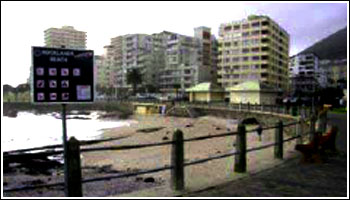 Rocklands Beach Photo: Leonardo Solomon ©
Rocklands Beach Photo: Leonardo Solomon ©
Sheila Vaughn remembers the days spent on Rocklands beach: “We played together, caught fish, collected shells, made toy canoes out of a certain sea weed, with match sticks for seats. And of course, we swam. The boys, some of whom were older then most of the girls played games like ‘Bok-Bok’ which meant building high human towers with difficulty because they were always collapsing. The smallest boy would climb to the top. What a cheer went up when this was finally achieved. Boys also spent the summer holidays making sea worthy canoes from sheets of corrugated iron beaten out flat. Two sturdy strips of wood for each end a lump of melted tar. Scraped off the edge of the road on a hot summers afternoon. They used to paddle far out in calm weather, the favourite place being the wreck at Mouille Point. Many boys were masters at surfing in their canoes from way out starting with a budding wave and rising higher and higher, reaching the beach at a great and amazing speed.”32
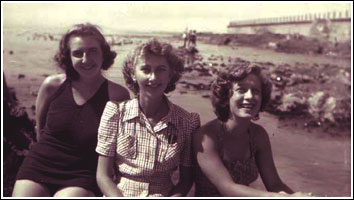 Sheila (centre) with her friends on Rocklands beach (1942) Photo: Sheila Vaughan ©
Sheila (centre) with her friends on Rocklands beach (1942) Photo: Sheila Vaughan ©
Daniel Vaughan remembers; “In summer the beaches belonged to us, and homework would if at all possible be left to when it was too dark to swim or canoe. Our tin canoes, made from flattened sheets of old corrugated iron were the surfboards of those days and summer afternoons seemed endless with surfing or ‘reefing’ or just paddling about. It made no difference to our fun when the summer westerly blew; we learned to be careful in a strong south-Easter.
There were great gales off the coast in the mid nineteen-forties and Rocklands beach would be strewn with driftwood some of which we would drag up to the house, to be sawn and chopped small, and burned in the little bathroom furnace to heat our bath water.”33
Rosemary remembers how when she was a teen you were proud of your beach and remained loyal to it. “We were a clique of swimmers that became almost like family.
We would all meet on the beach every day. We would bring beautiful glasses and drink wine while we watched the sunset. That was our beach. Boating people went to Three Anchor Bay. The Saunders crowd was not me. I did not live that side, we walked to the beach. My friend was a Saunders rocks girl, she would not think of coming this side! The crowd at Saunders was more sophisticated.”34
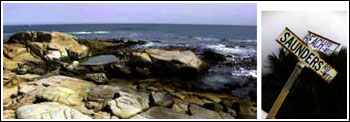 Saunders Rock Photo: Leonardo Solomon ©
Saunders Rock Photo: Leonardo Solomon ©
Sandra’s memories of Saunders: “I have always been beach mad. I went to all the beaches along the beachfront. Although we never went to Clifton. I grew up on Saunders. Now we go to Queens beach. I remember Saunders before the wall was built and we used to slide down the sand bank to get to the beach, with our picnics and umbrellas and everything! People had made a rough path. It was very natural and safe. I never went to Rockland s, this was our corner. We went as families. We would take out the old fashioned flask and have tea and sandwiches, it was very special.”35
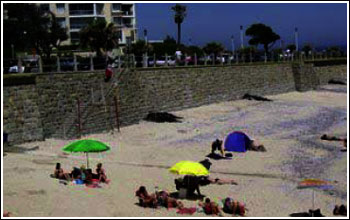 Queens Beach Photo: Leonardo Solomon ©
Queens Beach Photo: Leonardo Solomon ©
32 Sheila Vaughan, July 2008, written testimony 33Daniel Vaughan, 11th October 2008, interview via e-mail 34 Rosemary Magid, 10th October 2008, recorded interview 35 Sandra Sheinbar, 31st August 2008, recorded interview
<< previous Growing up at the Sea Point Pools —- Recreational activities for the youth next >>
Growing Sea Point Pools
A historical investigation into the Sea Point beachfront as a public open space throughout the 20th century with special reference to memories of growing up along the Sea Point Promenade by Leila Emdon.
Chapter Two continued – The growth of a suburb: the Development of Sea Point in the late 19th century to the 1950s
<< previous A Peaceful Suburb
Growing up at the Sea Point Pools
The pools along the Sea Point coast have an interesting history in that for decades people have enjoyed bathing. Today there is still the Milton Pool and the Saunders pool. Given the rough sea along the coast, these rock pools were made to be tidal pools, making it easier for people to swim. Opened in 1895, the Sea Point baths were built at the foot of Church Road. Above the pool, there was a wooden structure with cubicles, and there were, of course, separate bathing hours for men and women.26 The baths lasted until 1911 when a storm washed them away.
The first Sea Point baths before WW1 Photo: Under Lions Head ©
Later, the famous Pavilion opened in 1914 and served Sea Point for 40 years. 27 People have fond memories of the Pavilion, “On top of the pavilion was an open air cinema. Above the cubicles by the pool were a tearoom and an open-air stage. It was beautiful at night.”28
“The usual crowds of kids were also there during the holidays. Vic Davis and his band entertained us in all kinds of ways. We sat on the sand, watched, and listened with delight. He used to call children to come onto the stage to perform which we considered to be an honour.”29
Everyone I have spoken remembers with Joy the Vic Davis band, a treat for young people and brought many good memories.
“There were talent contests at the pavilion. The audience would boo you or cheer for you. Everyone would sit in their bathing costumes on the sand.”30
The Pavilion was later rebuilt to accommodate more people.
“Sea Point was more like a family residence. For instance the Pavilion, the old Pavilion, it had a restaurant upstairs, on the second level, and it had a smaller pool for kiddies surrounded by sand and the main sort of pool. Everybody knew everybody else because it was a much smaller community then.”31
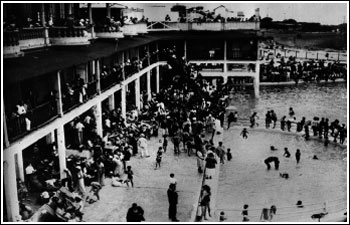 The old Pavilion in the 1930s Photo: I remember Cape Town ©
The old Pavilion in the 1930s Photo: I remember Cape Town ©
<< previous A Peaceful Suburb —- Childhood and Teenage Memories of the beaches and promenade next >>
Peaceful Suburb
A historical investigation into the Sea Point beachfront as a public open space throughout the 20th century with special reference to memories of growing up along the Sea Point Promenade by Leila Emdon.
Chapter Two continued – The growth of a suburb: the Development of Sea Point in the late 19th century to the 1950s
<< previous Growing up in Sea Point 1930s-1950s
A Peaceful Suburb
The Sea Point Beachfront 1930’s Photo: Shiela Vaughan ©
Growing up in Sea Point during the 1940s and 1950s seems to have been very simple and unstressed. “There were no shops, you ordered things from the grocer and he delivered.”22
“There were a couple of Greek cafes, and they sold small little things like cold drinks and ice creams and cigarettes. There were no super markets. Little Jacks was the first little super market. We lived on main road so we had a grocer there. You phoned the grocer and order what you wanted and they would send it over to you. There was a butcher, a fish shop and dry cleaner. It was a very unstressed lifestyle.”23
“The total population of the area was a fraction of that of today, and in the days where only the fairly well off could afford a car to travel across the Peninsula it was a suburb that belonged almost exclusively to its own people. As children then we were blissfully unaware of the sad reason for the absence of other races in our beaches and our parks. The proportion of children to adults was far higher then, and there were always enough neighbourhood children in the streets and the beaches for unending interaction and play.” 24
“We used to go sit by the palm trees on the beach front and picnic. It was quite and peaceful and safe. We could walk at night and alone.”25
22 Joe Maureberger, 31st Augus 2008, recorded interview
23 Sonia Kirsch, 20th September 2008, recorded interview
24 Daniel Vaughan, 11 October 2008, interview via e-mail
25 Rosemary Magid, 10 October 2008, Recorded interview
<< previous Growing up in Sea Point 1930s-1950s —- Growing up at the Sea Point Pools next >>
Growing 1930-1950
A historical investigation into the Sea Point beachfront as a public open space throughout the 20th century with special reference to memories of growing up along the Sea Point Promenade by Leila Emdon.
Chapter Two continued – The growth of a suburb: the Development of Sea Point in the late 19th century to the 1950s
<< previous Old Hotels, Estates of the Beach Rd and Main Rd Area
Growing up in Sea Point 1930s-1950s
All those I interviewed had a different experience of Sea Point. Joe Maureberger describes how: “There many children and the schools were packed, so there was no lack of friends.”17 The suburb was growing and many schools, churches and synagogues were opening. Sheila describes how: “Before the exodus of some families Sea Point was teaming with happy children. Schools and churches were packed, providing social activities as well as learning.”18 There were two large high schools, namely Ellerslie Girls High and Sea Point Boys High.
Sheila Vaughan grew up very close to the beachfront. “We lived in a lovely old fashioned, large Victorian house with a high veranda halfway around it. The house is near to the bottom of Rockland’s Road and looks rather stately these days with another story added to it which has copied the ground level floor and veranda.”19
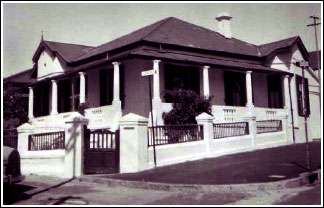 House where Sheila Vaughan grew up Photo: Sheila Vaughn ©
House where Sheila Vaughan grew up Photo: Sheila Vaughn ©
“It was the perfect family home, although I was only two and the only child so far. Today it would not be considered the perfect the family home, because the one and only toilet was outside in the back which the norm then. The hot water geyser was a wood burning one and every time you needed to bath you first had to make a fire in it.”
17 Joe Maureberger, 31st August 2008, recorded interview 18 Sheila Vaughan, July 2008, written testimony 19Sheila Vaughan, July 2008, written testimony 20 “Our house was homely, lovely and spacious and I learnt to love it. We were three children by now, each had our own room, and there were plenty of places to run around with our friends. The veranda was three quarters way around the house where there was also lots of place to play or sit and take in the winter sunshine.”20 Her brother Daniel Vaughn remembers “The sidewalks for an early evening stroll, to see and be seen. The lawns were a place, like today, for children and dogs to play. Our gardens were small and our streets narrow, but we had the lawns, and the wide Atlantic before us. Sea Point was a good place for children.”21
<< previous Old Hotels, Estates of the Beach Rd and Main Rd Area —- A Peaceful Suburb next >>
